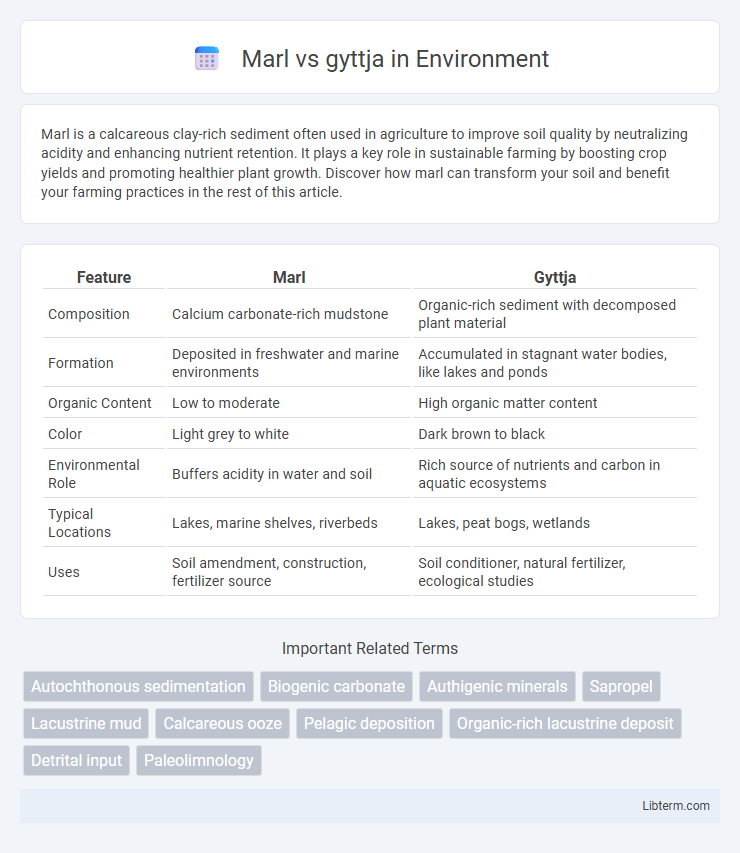Marl is a calcareous clay-rich sediment often used in agriculture to improve soil quality by neutralizing acidity and enhancing nutrient retention. It plays a key role in sustainable farming by boosting crop yields and promoting healthier plant growth. Discover how marl can transform your soil and benefit your farming practices in the rest of this article.
Table of Comparison
| Feature | Marl | Gyttja |
|---|---|---|
| Composition | Calcium carbonate-rich mudstone | Organic-rich sediment with decomposed plant material |
| Formation | Deposited in freshwater and marine environments | Accumulated in stagnant water bodies, like lakes and ponds |
| Organic Content | Low to moderate | High organic matter content |
| Color | Light grey to white | Dark brown to black |
| Environmental Role | Buffers acidity in water and soil | Rich source of nutrients and carbon in aquatic ecosystems |
| Typical Locations | Lakes, marine shelves, riverbeds | Lakes, peat bogs, wetlands |
| Uses | Soil amendment, construction, fertilizer source | Soil conditioner, natural fertilizer, ecological studies |
Introduction to Marl and Gyttja
Marl is a sedimentary mixture primarily composed of clay and calcium carbonate, often formed in freshwater or marine environments where calcium-rich waters promote carbonate precipitation. Gyttja consists of partially decomposed organic material found in lake sediments, characterized by its dark, nutrient-rich, and soft texture, resulting from anaerobic conditions that slow down organic decay. Both materials play crucial roles in reconstructing past environmental conditions and understanding sedimentary processes in aquatic ecosystems.
Geological Formation Processes
Marl forms through the chemical precipitation of calcium carbonate in freshwater or marine environments, often influenced by biological activity and sedimentation rates. Gyttja develops from the anaerobic decomposition of organic matter in lake sediments, resulting in a fine, carbon-rich mud rich in humic substances. The contrasting formation processes highlight marl's mineralogical deposition versus gyttja's biochemical accumulation in aquatic settings.
Physical and Chemical Properties
Marl is a calcium carbonate-rich sedimentary rock with a gritty, coarse texture and high pH typically around 8 to 9, containing significant amounts of clay and silt. Gyttja, a type of organic-rich mud formed from decomposed aquatic vegetation, exhibits a fine, soft texture with low mineral content and typically low pH values ranging from 4 to 6. Chemically, marl is dominated by inorganic calcium carbonate (CaCO3) often exceeding 30%, while gyttja is characterized by high organic carbon content often above 20%, with minimal carbonate minerals.
Distribution and Occurrence
Marl primarily occurs in freshwater and marine environments, often forming in lakes, ponds, and slow-moving rivers where calcium carbonate precipitates. Gyttja is typically found in anoxic, organic-rich lake bottoms where fine sediments accumulate under low oxygen conditions. Both materials are common in lacustrine settings but differ in formation processes and sediment composition.
Historical and Modern Uses
Marl, a calcium-rich sedimentary rock, has historically been used as a soil amendment to improve agricultural productivity by neutralizing soil acidity and supplying essential nutrients like calcium carbonate. Gyttja, an organic-rich sediment formed from decomposed aquatic plants and microorganisms, has been utilized in paleoenvironmental studies to reconstruct past climatic and ecological conditions, offering valuable insights into historical lake environments. Modern applications of marl continue to support sustainable agriculture, while gyttja serves as an important resource in environmental research and sediment analysis.
Ecological and Environmental Roles
Marl and gyttja play distinct ecological and environmental roles in aquatic and terrestrial ecosystems. Marl, rich in calcium carbonate, helps regulate water pH and provides essential nutrients that enhance soil fertility and aquatic life habitats. Gyttja, composed of decomposed organic matter in lake sediments, acts as a carbon sink and supports nutrient cycling, promoting biodiversity and maintaining water quality in freshwater environments.
Differences Between Marl and Gyttja
Marl is a calcium carbonate-rich sediment with a gritty texture, typically formed from the accumulation of shell fragments and inorganic mineral deposits, whereas gyttja is an organic-rich, dark mud composed primarily of decomposed plant material found in lake bottoms. Marl has a higher pH due to its limestone content and is often used to neutralize acidic soils, while gyttja contains more organic matter and nutrients, influencing its role in wetland ecosystems and sediment nutrient cycling. The unique mineralogical composition of marl contrasts sharply with the biochemical characteristics of gyttja, reflecting their differing environmental origins and sedimentation processes.
Methods of Identification and Analysis
Marl and gyttja can be identified and analyzed through sedimentological and geochemical methods, including grain size analysis, mineral composition, and organic content measurement. X-ray diffraction (XRD) helps determine the carbonate mineral content typical of marl, while loss on ignition (LOI) quantifies organic matter indicative of gyttja. Microscopic examination and elemental analysis, such as X-ray fluorescence (XRF), further distinguish the calcareous marl from the primarily organic-rich gyttja.
Importance in Paleoenvironmental Studies
Marl and gyttja both serve as critical sedimentary indicators in paleoenvironmental studies due to their unique compositions and depositional environments. Marl, rich in calcium carbonate, reveals past lacustrine conditions and paleoclimate variations, while gyttja, composed of organic-rich mud, provides insights into historic biological productivity and oxygenation levels in aquatic systems. Their stratigraphic analysis helps reconstruct historical climate shifts and ecosystem changes with high resolution.
Challenges and Future Research Directions
Marl and gyttja present challenges due to their complex geochemical composition and varying sedimentation rates, which complicate stratigraphic correlation and paleoenvironmental reconstructions. Future research should focus on advanced isotopic analysis and high-resolution sediment core sampling to improve understanding of diagenetic processes and organic matter preservation. Integrating remote sensing technologies and machine learning models can enhance predictive mapping and facilitate comprehensive assessments of these sediment types in changing climatic conditions.
Marl Infographic

 libterm.com
libterm.com